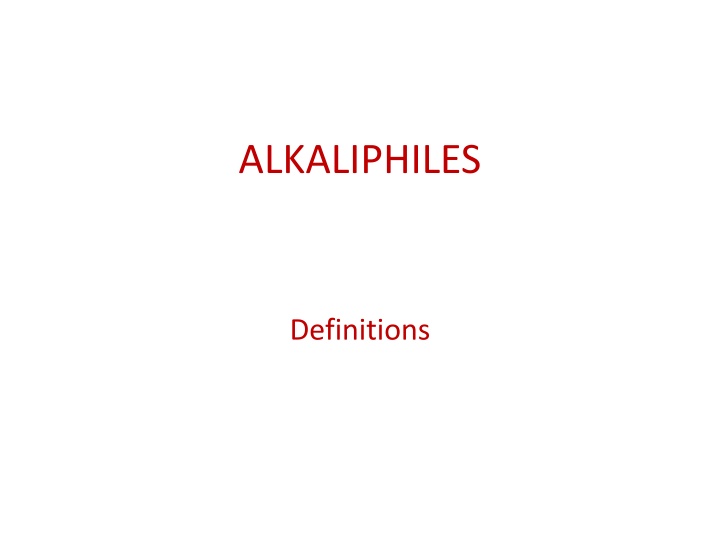
Exploring Alkaliphiles: Microbes Thriving in Extreme Environments
Discover the fascinating world of alkaliphiles, extremophilic microbes capable of surviving in alkaline environments. Learn about their mechanisms of cytosolic acidification, differences in ATP production, and the unique adaptations that allow them to thrive in high pH conditions.
Download Presentation

Please find below an Image/Link to download the presentation.
The content on the website is provided AS IS for your information and personal use only. It may not be sold, licensed, or shared on other websites without obtaining consent from the author. If you encounter any issues during the download, it is possible that the publisher has removed the file from their server.
You are allowed to download the files provided on this website for personal or commercial use, subject to the condition that they are used lawfully. All files are the property of their respective owners.
The content on the website is provided AS IS for your information and personal use only. It may not be sold, licensed, or shared on other websites without obtaining consent from the author.
E N D
Presentation Transcript
ALKALIPHILES Definitions
Alkaliphiles are a class of extremophilic microbes capable of survival in alkaline (pH roughly 8.5-11) environments, growing optimally around a pH of 10. further categorized as obligate alkaliphiles (those that require high pH to survive), facultative alkaliphiles (those able to survive in high pH, but also grow under normal conditions) haloalakliphiles (those that require high salt content to survive) Mechanisms of cytosolic acidification. Alkaliphiles maintain cytosolic acidification through both passive and active means. In passive acidification, it has been proposed that cell walls contain acidic polymers composed of residues such as galacturonic acid, gluconic acid, glutamic acid, aspartic acid, and phosphoric acid. Together, these residues form an acidic matrix that helps protect the plasma membrane from alkaline conditions by preventing the entry of hydroxide ions, and allowing for the uptake of sodium and hydronium ions.
In addition, the peptidoglycan in alkaliphilic B. subtilis has been observed to contain higher levels of hexosamines and amino acids as compared to its neutrophilic counterpart. When alkaliphiles lose these acidic residues in the form of induced mutations, it has been shown that their ability to grow in alkaline conditions is severely hindered. However, it is generally agreed upon that passive methods of cytosolic acidification are not sufficient to maintain an internal pH 2-2.3 levels blow that of external pH; there must also be active forms of acidification. . The most characterized method of active acidification is in the form of Na+/H+ antiporters. In this model, H+ ions are first extruded through the electron transport chain in respiring cells and to some extent through an ATPase in fermentative cells. This proton extrusion establishes a proton gradient that drives electrogenic antiporters which drive intracellular Na+ out of the cell in exchange for a greater number of H+ ions, leading to the net accumulation of internal protons. This proton accumulation leads to a lowering of cytosolic pH. The extruded Na+ can be used for solute symport, which are necessary for cellular processes. It has been noted that Na+/H+ antiport is required for alkaliphilic growth, whereas either K+/H+ antiporters or Na+/H+ antiporters can be utilized by neutrophilic bacteria. If Na+/H+ antiporters are disabled through mutation or another means, the bacteria are rendered neutrophilic.[4][5] The sodium required for this antiport system is the reason some alkaliphiles can only grow in saline environments
Differences in alkaliphilic ATP production In addition to the method of proton extrusion discussed above, it is believed that the general method of cellular respiration is different in obligate alkaliphiles as compared to neutrophiles. Generally, ATP production operates by establishing a proton gradient (greater H+ concentration outside the membrane) and a transmembrane electrical potential (with a positive charge outside the membrane). However, since alkaliphiles have a reversed pH gradient, it would seem that ATP production which is based on a strong proton motive force would be severely reduced. However, the opposite is true. It has been proposed that while the pH gradient has been reversed, the transmembrane electrical potential is greatly increased. This increase in charge causes the production of greater amounts of ATP by each translocated proton when driven through an ATPase.[6][7] Research in this area is ongoing.

